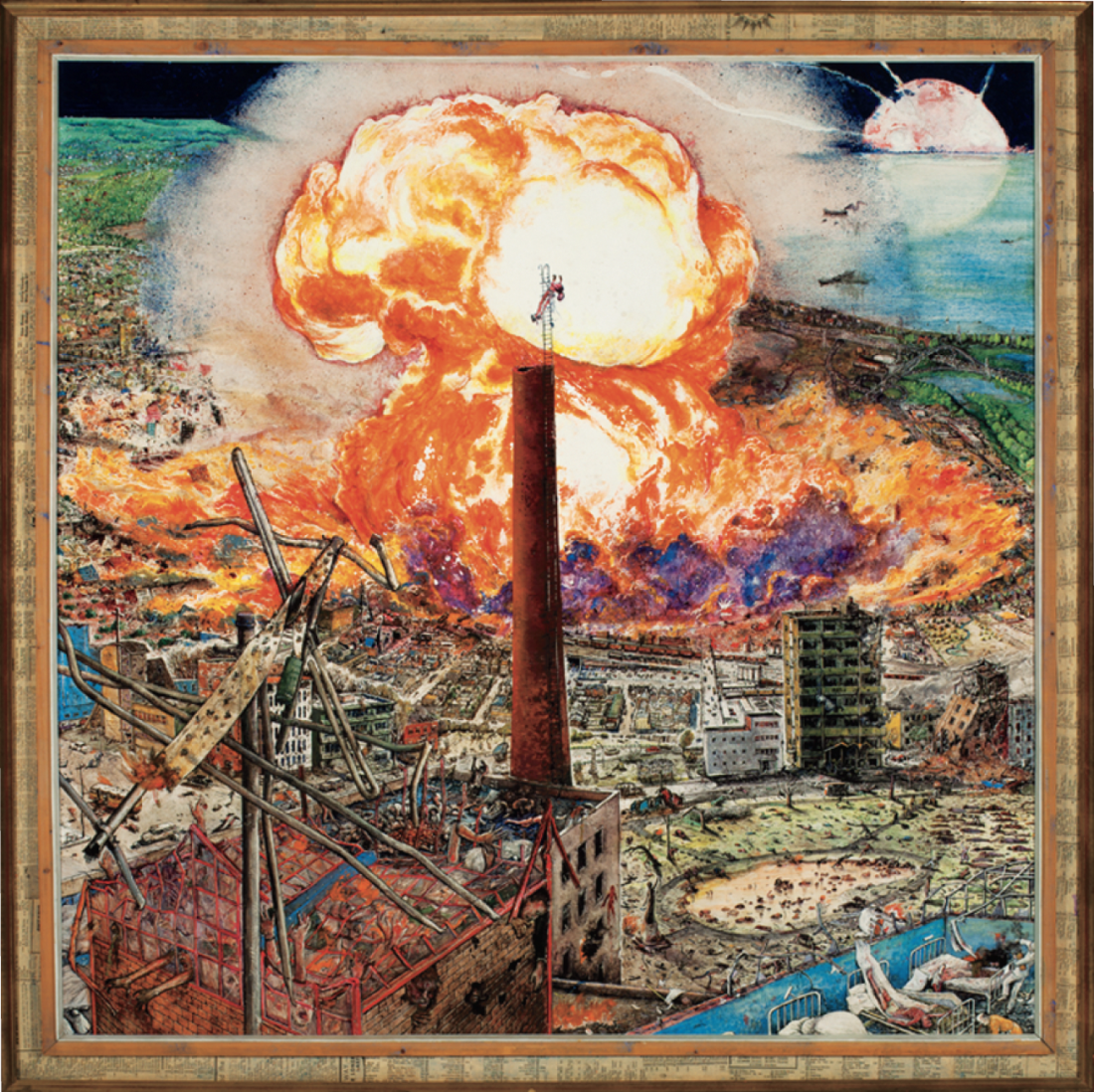William Kurelek
It probably irked the 1961 Canadian art world when Alfred Barr Jr., director of the Museum of Modern Art in New York City, chose a realistic painting of farm life by William Kurelek over several abstract works for the MoMA’s collection. At the time, Modernist hardliners defined abstraction as stringent, self-criticizing and contemporary, while viewing narrative painting as nostalgic, naive and cluttered with literary subject matter.
The ongoing re-evaluation of Modernism has suggested that these polarizations aren’t much use. In fact, as this revealing and ambitious retrospective suggests, Kurelek’s work remains stubbornly unclassifiable, being a prickly, difficult and deeply discomfiting mix of technical virtuosity and personal obsession, modern anxiety and medieval wrath. Co-curators Tobi Bruce, Mary Jo Hughes and Andrew Kear have gathered more than 80 paintings and works on paper, carefully exploring the sharp hinges along which Kurelek’s vision developed—his meticulously detailed visual memories of his prairie childhood and his startling, intense religiosity. For Kurelek, who converted to Roman Catholicism in 1957 after a suicide attempt and a devastating episode of mental illness, religion was sometimes a refuge and more often a cudgel with which to beat a frightening and incomprehensible world. Kurelek’s profound piety, in particular his besetting sense of humankind’s sin, will seem alien to many contemporary viewers, but it is also a site of struggle and uncomfortably naked expression. In the end, it’s the sense that Kurelek’s works have been created in the grip of inescapable emotion that makes his art feel modern.
Early in his career, Kurelek made the conscious decision that his “potboilers,” as he rather dismissively called his depictions of Ukrainian-Canadian culture and the seasonal rituals of rural life, would underwrite the so-called “message” paintings of his religious mission. The show’s curators suggest that the relationship between these two genres is complicated. Many viewers—and I’d include myself here—probably knew Kurelek primarily from his bestselling children’s books, A Prairie Boy’s Winter (Tundra Books, 1973) and A Prairie Boy’s Summer (Tundra Books, 1975), carefully rendered visual records of hard work and simple pleasures proceeding under the cloudless clarity of a big western sky. This exhibition deals frankly with viewer expectations, setting out both the sunny art we think we know and its dark counterpoint—aggressive, disturbing and driven works like I Spit on Life, a watercolour created some time in 1953 or 1954, whose despairing title is matched by its horrific gothic imagery.
Several works are obsessively introspective. The Maze, painted in 1953 when Kurelek was undergoing psychiatric treatment at the Maudsley Hospital in London, England, is a morbid psychological self-portrait. A skull is cut open to reveal a welter of anger, fear, self-loathing and sexual guilt. Through a jarring mix of detailed realism and bizarre imagery, this tortured painting suggests the circular rat-trap of depressive thinking. (In a decidedly strange pop-culture pairing, the painting later became the cover of a 1981 Van Halen album, Fair Warning.)

William Kurelek, This is the Nemesis, 1965, mixed media on Masonite, 114.8 x 115.6 cm. Art Gallery of Hamilton: Gift of Mrs. J.A. McCuaig, 1966. Corporate Collection, Toronto. Photograph: Robert McNair. © the Estate of William Kurelek. Courtesy Wynick/Tuck Gallery, Toronto, and Winnipeg Art Gallery. 50147txt.
In the 1960s, Kurelek’s anxieties turned outward, at some point taking the nuclear threat of the Cold War period and cranking it up to a pitch of apocalyptic destruction. (It is significant that Kurelek’s basement studio in Toronto had originally been designed as a bomb shelter for his family. Its cramped, sunless, airless atmosphere, pervaded with Atomic Age fears, seems to have presided over much of his later painting.) For Kurelek, nuclear annihilation becomes the 20th-century version of the medieval Judgement Day, with southern Ontario’s sinners drowning in lakes of fire or blasted into mushroom clouds of flame. In several works, Kurelek lacerates mass culture, consumerism, rationalism and what he calls “mere humanism,” applying the grotesque imagery of Bosch to secular society and venting his hatred of the Kinsey Reports, abortion, television, advertising and shiny kitchen appliances.
Less bombastic, and more interesting, are the pieces that combine the two strains of Kurelek’s work, quietly imbuing prosaic prairie realities with a spiritual dimension. In Dinnertime on the Prairies, 1963, a bloodied Christ is crucified with fence posts and barbed wire in the middle of a wheat field. In We Find All Kinds of Excuses, 1964, the Virgin and Christ child shelter in a winter haystack, ignored by playing children and a labouring man, with only benignly incurious cattle for company.
Sometimes the relationship between emotional memory and religious dogma is even subtler. Many of Kurelek’s childhood scenes can seem like happy primers of quaint, old-fashioned fun, as kids build snow forts, cool off at the swimming hole and play games like Fox and Geese and Hide and Seek. Once we’ve seen Kurelek’s brimstone paintings, however, many of his depictions of children are suddenly recast as allegories of power, submission and exclusion, cruelty and waywardness. Suddenly, the children represent not innocence but original sin.
That’s perhaps the signal achievement of this rigorous and exhaustively researched exhibition. In its presentation of works that act and react against each other, it gives us a fuller (and considerably darker) view of Kurelek’s life and art. With its uncomfortable, often unexpected mix of prairie reminiscence and chiliastic doom, “The Messenger” casts new light on a well known—but in another sense, little known— Canadian artist. ❚
“William Kurelek: The Messenger” was exhibited at the Winnipeg Art Gallery, from September 29 to December 31, 2011. The exhibition will travel to the Art Gallery of Hamilton, from January 28 to April 29, 2012, and the Art Gallery of Greater Victoria, from May 25 to September 3, 2012.
Alison Gillmor is the Pop culture columnist for the Winnipeg Free Press and writes regularly on visual arts and film.

